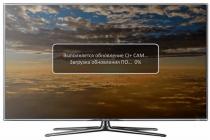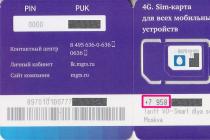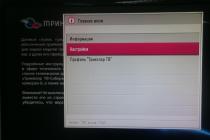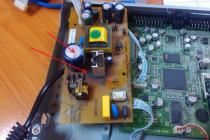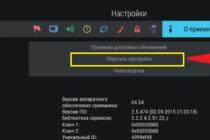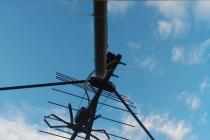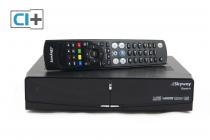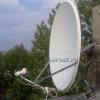- Telephone
- Battery
- Wired headset
- Power adapter with USB cable
- Warranty card

Maintaining
The Blast smartphone is an average device in all parameters in the updated Highscreen line, if we take into account the separately standing powerful Explosion. The main difference new series devices - using a chipset from Qualcomm, in this case MSM8225, not MediaTek. However, despite the change of the chipset, based on benchmarks and the work of gadgets in practice, the performance remained at the same level as the dual-core MediaTek MT6577. However, if friends or acquaintances ask you about which chip your cool device operates on, you can proudly answer that on Qualcomm Snapdragon S4!
Otherwise, Highscreen Blast is normal good smartphone: 4.5 inches diagonal of the screen, IPS matrix with qHD resolution, 768 MB random access memory, a capacious 2000 mAh battery, an 8 MP camera and, of course, support for two SIM cards. But still, the main feature of the device, I consider the camera. For inexpensive device she shoots in any lighting conditions just fine. But I'll talk about it a little later in a separate section.
The phone is already on sale in stores for 8,000 rubles.
Design, dimensions, controls
Appearance Blast - a typical faceless budget "android": a rectangle with smooth edges in black. The edging is made of dark chrome-plated plastic, the rear semi-gloss cover is black and has a raised surface in the form of small recesses. Dimensions are standard for most of these devices - 131x67x9.9 mm, weight - 145 grams. It turns out a large and not the lightest brick. It fits well in the hand thanks to the elongated screen, sloping edges and soft-touch materials.
The assembly is perfect: the socket is firmly held by numerous rivets, does not creak or play, when pressed on the central area of the back cover, the case does not push through to the battery. The screen is protected by glass, not plastic, so it will be difficult to scratch it: not a single scratch has appeared in a month of "use". Despite the absence of marketing chips such as an oleophobic display coating, there are practically no fingerprints on its surface, at least no white coating appears. Of course, this is a huge plus.

Front-camera, two sensors - proximity and lighting, - the speech speaker is located on the front panel from above. The first sensor reacts very quickly, and during the operation of the device, there were no false screen lock disconnections at the time of the call. The second sensor correctly and smoothly adjusts the brightness level of the backlight. There are no complaints about him either.

The volume of the speech loudspeaker is slightly higher than average, the interlocutor can be heard clearly and legibly, the timbre is generally pleasant: mainly mid and high frequencies are heard. At maximum volume, it does not wheeze or rattle.
Below the display are located touch buttons: "Search", "Back", "Menu" and "Home". They are applied in white translucent paint and have a very bright backlight. The microphone is under "Search".


On the top there are microUSB without a cap and a standard 3.5 mm audio output, while on the bottom there are no elements.


At the top right is the on / off button for the device. Small and thin, almost recessed into the body, the stroke is average, and the pressure is soft. On the left is the same type of volume rocker.


On the back side, the camera module rises by 3 mm, framed by a chrome-plated rim, next to it is a single-section flash. The speaker is located at the bottom.



To open the lid, you must pry it off by the notch at the bottom of the case. The memory card is inserted in the upper right (hot-swappable), SIM card slots - to the left.

Comparative sizes:

Highscreen Blast and Samsung Galaxy Note II

Highscreen Blast and Sharp SH930U

Highscreen Blast and Meizu MX2

Display
This smartphone has a 4.5-inch diagonal screen (physical size 55x99 mm) with an aspect ratio of 16x9. Display resolution - 540x960 (qHD) pixels, density - 244 ppi. The pixelation is not striking, but if you look closely, you can see a grid of pixels. The touch layer, of course, of a capacitive type, fulfills up to five simultaneous touches. The sensitivity of the touch layer is excellent and is comparable to the sensitivity of displays in top-end phones.

The Highscreen Blast matrix is made using IPS technology and is capable of displaying 16 million color shades. The viewing angles of the screen are large: under tilts, the brightness only drops slightly. Color reproduction is natural. At certain angles, particularly vigilant users may notice a slight purple tint.

In the light, the picture is clearly visible, in the direct rays of the sun the image fades, but in general everything is fine.

Settings:




Battery
Highscreen Blast uses a removable lithium-ion (Li-Ion) battery with a capacity of 2000 mAh, 3.7 V. Type - blast. Tests have shown that the power consumption of the Qualcomm MSM8225 chipset is almost the same as that of the MediaTek MT6577.

If you use the phone for about 8-9 hours, the battery will be completely discharged provided: 20-25 minutes of talks a day, 2 hours of constant use of Wi-Fi Internet (Twitter, mail, downloading applications and installing them), about 5- hours of mobile internet and hours of listening to music.



You can listen to music only for 30 hours, watch only video (maximum screen brightness, high volume, movie resolution - HD 720p) - just over 3 hours. If you want to play toys (for example, MassEffect Infiltrator), the battery will run out after 3 hours.
Communication capabilities
The phone works in cellular networks 2G (GSM / GPRS / EDGE, 850/900/1800/1900 MHz) and 3G (900/2100 MHz). In this case, one SIM card (SIM2 - slot on the right) functions only in 2G, the other - in 2G or 3G (SIM1 - slot on the left). If used Mobile Internet, then traffic is limited in the settings - a special feature of Android 4.0. In the settings section "SIM-cards management" you can set the name of "SIM-cards" and data transfer.


In stock Bluetooth version 3.0 (EDR / A2DP / DUN / FTP / OPP / SPP / HFP / AVRCP) for file and voice transmission. There is a wireless Wi-Fi connection IEEE 802.11 b / g / n. The device, of course, can be used as an access point (Wi-Fi Hotspot) or a modem. In the settings, this item is listed as "Modem mode". There were no problems with the connection, the Wi-Fi sensitivity is high.
USB 2.0 (High-Speed) is used for file transfer and data synchronization.
Memory and memory card
The smartphone uses 768 MB of RAM, of which about 340 MB is free. An excellent indicator, considering that the device costs 8,000 rubles. Usually, such gadgets have no more than 512 MB of RAM and about 170 MB of free space.



For data storage, 1 GB of Flash memory is allocated, for installing programs and games - a little less than 2 GB. In the settings, you can select in advance the installation location of applications: on internal memory, on microSD card or leave it to the discretion of the system. I would recommend buying a card large capacity and put a check mark on "Removable SD card".
Camera
In almost every modern smartphone there are two camera modules - front and main. In Blast, the first module has a resolution of 2 MP (most likely, interpolation, judging by the quality of the images), the second - 8 MP. A single-section LED acts as a backlight. Maximum photo resolution - 2560x1920 pixels, video - 1280x720 pixels at 15 frames per second.
As I said at the beginning of the review, the new product received a very cool camera. Frankly speaking, I haven't seen such high-quality shots taken on budget smartphone... First of all, it is worth noting the natural color rendition, the fairly accurate work of the white balance. In the second - detail and good lens aperture. Unfortunately, the value of the aperture number is unknown, but offhand - f2.2. Interestingly, the Blast shoots better than the flagship Explosion.
But the videos were a bit disappointing: the picture quality is more or less good, but the number of frames is only 15. Either the developers cheated, or the chipset does not pull more frames in HD-resolution. However, the sound recording is decent - AAC 156 Kbps 48 kHz - clean, no clutter.
Skype program works fine.
The view of "Cameras" has been slightly changed, but in general the settings are familiar to Android 4.0.x









Video file characteristic:
- File format: 3GP
- Video codec: AVC, 4000 Mbps
- Resolution: 1280 x 720, 15 fps
- Audio codec: AAC, 156 Kbps
- Channels: 1 channel, 48 kHz
Sample photos:













































Performance
Almost all modern low-cost Android smartphones operate on single-core or dual-core chipsets from the Taiwanese company MediaTek. The chip is cheap, the power consumption is low, and the performance is quite good. In any case, many toys go without problems, videos are played in a resolution of up to 720p, which is cool enough, for example, for "androids" for 5,000 - 6,000 rubles.
When I read in the specifications of a new line of devices from Vobis Computer that they have a Qualcomm Snapdragon S4 chipset, I was surprised a lot. However, later it turned out that although the chip belongs to the S4 generation, the MSM8225 is considered the weakest in the class: the 45 nm process technology, the AMRv7 instruction set, maximum frequency 1.2 GHz (two cores ARM Cortex-A5), graphics accelerator Adreno 203.

If we compare the chipsets Qualcomm MSM8225 and MediaTek MT6577, then I did not notice the difference. Both have difficulty "digest" HD-video, not all toys are available (you shouldn't dream of powerful ones *), the interface speed is relatively smooth. Actually, the performance tests say the same thing.
In general, miracles do not happen.
* - Installed but did not start: The Amazing Spider-Man, NOVA3, Dead Space.
A short technical description smartphone and benchmarks:




How to set up Internet on Highscreen.
V modern world almost every person has a mobile device, or rather a smartphone. A prerequisite for a modern smartphone user is the ability to connect to the Internet.
Highscreen devices provide this opportunity. But just buying a smartphone does not mean immediately connecting to the Internet. First you need to buy a service from your mobile operator... It is very important to choose the right rate. Depending on your requests, you can choose either unlimited or tariffed access.
It is also important to know how to set up such a connection. As a rule, the settings come by themselves, you only need to save them. In some cases, it is not possible to configure the Internet the first time; in such situations, manual setting.
If you do not know how to manually configure the Internet on a Highscreen device, then this material is just for you. We will tell you in detail how to set up the Internet using GPRS. This process does not require much effort from you. Just follow the instructions carefully. It is also important to know why you were unable to access the first time. We will also provide a list of these reasons.
Before manual tuning ...
1) You need to activate the "data transfer" parameter in the settings. This is necessary to open access for data transmission from the network. You can find this option in the menu item "mobile network settings".
2) If you do not have enough funds in your account, then you should replenish it, otherwise it is not possible to go online.
To understand when you have a connection to the network, look at the connection indicator. There should be an alphabetic symbol next to it, which means an Internet connection. If you have taken into account all the above points, then proceed to manual settings.
Setting up the Internet manually.
1) Go to the "Settings" menu.
2) Open the item "more", and then go to the column "mobile networks".
3) Here you need to select the "access point" parameter.
4) If in the list of access points there is one that belongs to your operator, then it is enough to activate it, and access is obtained.
5) Otherwise, we proceed to create a new access point. To do this, select the line "new ..." in the list of functions.
6) A new window will open. There will be empty fields and they need to be filled with certain information (). Without errors, you must fill in the "APN" field.
8) Save the created access point.
9) Pay attention to the communication indicator, if there is a letter next to it, then the connection was successful.
10) If the connection is not activated the first time, then restart the device.
There are several reasons why you cannot access the Internet. Among them, such as incorrect filling of fields when creating a new account, faulty device, being out of the network coverage area. Analyze all factors and define the problem. If you yourself cannot determine what is the reason, contact the specialists.
This is the official instruction for Highscreen Power ice in Russian, which is suitable for Android 5.1. In case you have updated your Highscreen smartphone to a more "fresh" version or "rolled back" to an earlier version, then you should try others detailed instructions manual, which will be presented below. We also suggest that you familiarize yourself with quick instructions user in question - answer format.
Highscreen official site?
You have come to the point, because all the information from the official website of the Highscreen company is collected here, as well as a lot of other useful content.
Settings-> About phone :: Android version(a few clicks on the item will launch the "Easter Egg") ["Out of the box" version of Android OS - 5.1].
We continue to configure the smartphone
How to update drivers on Highscreen

You need to go to "Settings -> About phone -> Kernel version"
How to enable Russian keyboard layout
Go to the arzdel "Settings-> Language and input-> Select language"
How to connect 4g or switch to 2G, 3G
"Settings-> More-> Mobile network-> Data transmission"
What to do if turned on child mode and forgot password
Go to "Settings-> Language and keyboard-> section (keyboard and input methods) -> put a tick in front of" google voice input "
.png)
Settings-> Display :: Auto-rotate screen (uncheck)
How to set an alarm ringtone?
.png)
Settings-> Display-> Brightness-> Right (increase); left (decrease); AUTO (automatic adjustment).
.jpg)
Settings-> Battery-> Power saving (check the box)
Enable display of battery charge status as a percentage
Settings-> Battery-> Battery Charge
How to transfer phone numbers from SIM-card to phone memory? Importing numbers from a SIM card
- Go to the "Contacts" application
- Click on the "Options" button -> select "Import / Export"
- Select where you want to import contacts -> "Import from SIM-card"
How do I add a contact to the blacklist or block a phone number?
How to set up the Internet if the Internet does not work (for example, MTS, Beeline, Tele2, Life)
- You can contact the operator
- Or read the instructions for
How to set a ringtone to a subscriber so that each number has its own melody

Go to the "Contacts" application -> Select required contact-> click on it -> open the menu (3 vertical dots) -> Set ringtone
How do I disable or enable the vibration feedback of the keys?
 Go to Settings-> Language & input -> Android keyboard or google keyboard-> Vibration feedback of keys (remove or put a check mark)
Go to Settings-> Language & input -> Android keyboard or google keyboard-> Vibration feedback of keys (remove or put a check mark)
How do I set a melody for an SMS message or change the notification sounds?
Read the instructions for
How do you know which processor is on Power Ice?
You need to look at the characteristics of Power Ice (the link is above). We know that in this modification of the device the chipset is MediaTek MT6735, 1300 MHz.
.png)
Settings-> For Developers-> USB Debugging
If there is no "For Developers" item?
Follow the steps from the instructions
.png)
Settings-> Data transfer-> Mobile traffic.
Settings-> More-> Mobile network-> 3G / 4G services (if the operator does not support, select only 2G)
How do I change or add the keyboard input language?
Settings-> Language and input-> Android keyboard-> settings icon-> Input languages (puts a checkmark in front of the necessary ones)
When at the end of last year I first of all paid attention to the size of the battery - I really didn't want to charge it every evening. Then I settled on a smartphone with a 3300 mAh battery. Recently there was an opportunity to test another long-lived phone - Highscreen boost with a battery capacity of 4160 mAh. The review will be devoted to this device. Sometimes I will compare Highscreen boost with Motorola Razr MAXX, and I must say that in many ways this comparison will not be in favor of the latter.
Externally, the Highscreen boost looks like this.
Later we will look at it from all sides and look inside.
Iron
Let's start with dry numbers of characteristics, then we'll talk about the parameters in more detail.
- The screen (IPS technology, manufactured by Sharp) has a size of 4.3 inches with a capacitive sensor and multitouch support.
- Screen resolution 540 × 960 pixels (256 PPI).
- Supported communication standards GSM 900/1800/1900, 3G.
- Support for two SIM-cards.
- Processor dual-core Qualcomm MSM8225, 1400 MHz.
- The amount of RAM is 1 GB.
- The built-in memory for storing data is 4 GB.
- For data storage, you can use microSD cards up to 32 GB.
- The battery is replaceable for 4160 mAh.
- Operating system - Android 4.1.2.
- The camera on the back side of the case has a resolution of 8 megapixels (with autofocus), and on the front - 1.3 megapixels.
- There is GPS support.
- Supported wireless communication protocols - WiFi, Bluetooth.
- There are light sensors, proximity and compass.
Equipment
The phone is sold in a compact cardboard box, on which the insides of the device are drawn in section (almost according to ESKD) and its main characteristics are written.

In addition to the smartphone itself, the kit includes headphones, a charger, a USB-microUSB cable and a short instruction manual.

The charger is quite powerful, the output current that it gives is 1 A. This is justified, after all, the phone's battery has a large capacity, and it would charge forever from a low-power charge.

Also, the phone can be charged from USB port, but given the capacity of the battery, this will not be the fastest charging, to put it mildly.
The included earbuds are regular earbuds, so you shouldn't expect any special sound quality or sound insulation from them. They connect using a standard 3.5mm jack, so music lovers can always plug in their favorite headphones.

No phone case is included, which is unfortunately standard practice.
Phone appearance
Now, as for the very Highscreen phone Boost. I am not an esthete and all sorts of "rounded edges" bother me a little, so there are no special claims to his outward appearance I do not have. It lies comfortably in the hand.
With the same screen sizes, the Highscreen boost body is noticeably smaller than that of the Motorola Razr MAXX.

But in comparison with it, it is almost twice as thick and slightly heavier - by 40 g (185 g versus 145 for Motorola, if you believe official characteristics). On next photo on the left - Highscreen boost, on the right - Motorola Razr MAXX.

On the front panel of the phone there are three touch buttons: "Menu", "Return to the desktop" and "Back". There is no "Search" button, but I never used it in Motorola.
The power button is located on the top right side of the case (in the next photo on the right).
Attentive readers may notice on the same side below (in the photo on the left) another button of unknown purpose with a drawn Tetris figure. It took me a while to realize that this is how the designers drew the camera. With a long press on this button, you can call the application for photographing (if the phone screen is unlocked). But the most interesting thing is that this button works in the same way as in "adult" cameras. When taking a photo, pressing the button halfway will focus on the selected area, and pressing it fully will take the photo. This button is useful if you hold your phone horizontally when taking pictures. I'm usually not comfortable taking pictures with my phone, when you have to press a button on the screen to “release the shutter”.
On the other side there are volume up / down buttons.

Buttons for changing the volume (they are on the left and look like one big button) are not easy to distinguish from the influx on the case, and when you press it, you doubt whether you are pressing the volume up or down button. I like it better when they are separated and can be groped blindly.
At the bottom there is a microUSB connector for connecting to a computer or to charger... There is also a hole for the microphone.

The headphone jack is located on top.

The back side looks like this:

Here, from left to right, are located: a flash consisting of two LEDs, a camera lens and a speaker. The loudspeaker, by the way, is quite loud, so if you don't hear a call or a message about the arrival of an SMS, it is not the fault of the phone.
Unfortunately, the phone has no indicators of missed calls and messages. In order to find out if someone called while you were in the bathroom, you will have to turn on the screen.
There are also small quibbles about the speaker through which you listen to the interlocutor. From time to time there is a feeling that he "rings", sometimes during a conversation some high frequencies slip, as if this speaker is working at the volume limit.
Before turning on the phone, let's take a look at its insides.
Meet this battery, it has a capacity of 4160 mAh.

From the next photo, you can roughly estimate how much the battery occupies in the phone. Hence the thickness of the Highscreen boost.

As you might have guessed, the smartphone's battery is removable (unlike the Motorola Razr MAXX battery).
But the "guts" of the phone without a battery.

At the top left there are holders for two SIM-cards, a little to the right is a holder for a microSD card.
For many, it will be convenient that a normal SIM card is inserted here (formally it is called a mini-SIM), and not a "cropped" micro-SIM. So if you switch to Highscreen Boost from an old phone, then you will not have to run to the communication salon to exchange a SIM card or to cut it off (the Motorola Razr MAXX uses a micro-SIM, and there is no support for two SIM cards).
There are no complaints about the quality of the phone, the interlocutor is heard normally. You can find fault with the fact that when you press the keys, the vibration (if it is on) is rather weak, but this is as you like.
Now let's talk about the Highscreen boost screen. It is based on IPS technology, of course, there is multitouch support. Its brightness is quite enough, to save the battery, I switched its brightness to 50%, the automatic brightness adjustment did not impress me - it somehow painfully often changes the brightness. Unfortunately, due to cloudy weather, we were unable to test how well the screen can be seen in the bright sun.
The main drawback of the screen (and, in my opinion, of the entire phone) is the low sensitivity of the sensor. Despite the fact that it is capacitive, you often have to press a little harder on the screen in order for the phone to respond to the press. With a weak touch to the screen, the phone does not always notice pressing.
The camera in the phone is, to put it mildly, so-so. You can see examples of photos taken with Highscreen boost at the following links:,.
While the front-facing camera is not designed for photography, it will do just fine for video conferencing. At least you can see the outlines of the interlocutor -.
On the other hand, we were pleased with the performance tests of this phone. According to the Quadrant Stardart 2.1.1 Highscreen boost tests, it overtook the Motorola Razr MAXX and scored 3328 points (versus Motorola's 2662 points), which can be seen from the following screenshot:

Now let's talk about the most strong side phone - battery. I was very impressed with the battery life. If during not very active use (use as a notebook, several calls and SMS per day) Motorola Razr MAXX lives for three days, then the Highscreen boost lasted almost six days.


It really surprised me, because although its capacity is higher than that of Motorola, it is not twice as large. The answer lies in the fact that the Motorola Razr MAXX has a screen made using AMOLED technology with a large advantage in terms of gluttony, and the screen in Highscreen boost consumes noticeably less (here the most gluttonous is the GSM receiver). True, most of the time the screen worked for me at 50% brightness (in Motorola I always have automatic brightness control enabled).
Software
As for the software part of the smartphone, there is nothing special to tell, since the quality operating system almost naked Android 4.1.2 is used without any extra installed applications.

For me, this is rather a plus, since the necessary software can always be installed, but in order to remove unnecessary programs included in the kit, you need to perform dances with a tambourine. On the other hand, the pre-installed programs could be useful for those who have not yet dealt with Android.
You can see the programs that are installed by default in the following screenshots.


The desktop consists of five swiping screens. By default, they have some widgets like an analog clock.

... on / off buttons for WiFi, Bluetooth, GPS, sync and screen brightness

... and gallery widget

If you slide your finger across the screen from its upper border to its bottom, a message panel will open with convenient on / off buttons different modes(the same WiFi, Bluetooth and some others like data transfer via mobile Internet).


For example, I will also give a screenshot of the camera application.
Unfortunately, this function does not work on all our smartphones.
List of Supported Devices:
Highscreen spade
Highscreen ice 2
Highscreen Zera F - any revision
Highscreen Zera S - any revision
Highscreen zera u
Highscreen Hercules
Highscreen Boost 3
Highscreen Boost 3 PRO
Procedure:
1) Turn off the device.
2) After the smartphone is completely turned off, hold down the power and volume up keys at the same time and hold them.
Some devices will require you to choose which mode to start them in. You must select “ Recovery mode”With the volume up key and confirm the selection with the volume down key.
Also, the Android logo and the inscription “No command” may appear on the screen. In this case, press the center touch key “Home” or press the power button once.
3) In the menu that appears, use the volume down key to select “backup user data”.
* To confirm your choice on different devices you may need to press: the volume up key, the left touch key “Menu”, or the left touch point.
4) Wait until the process of copying your data is completed.
5) After completing it, you will again be taken to recovery menu, where you should select the top item “reboot system now” and confirm your choice.
6) After turning on the device, connect the smartphone to the PC and go to the device memory (or SD card, if installed).
7) A recovery file has formed in the root directory of the device memory, which looks like the following: “userdata_20141101_000026.backup” (numbers may differ). It should be copied to your PC.
* If you have an SD memory card installed, then the file is formed on it. Removable storage will not be erased when formatted. In this case, you do not need to copy the recovery file to your PC.
8) Now you can perform the standard reset or hard-reset procedure. This procedure completely clears the built-in memory of the device.
9) After the reset is complete, completely disconnect your device again and go to the “recovery menu” as described in step 2.
10) When this menu appears, select “restore user data”.
Select the path to the recovery file: “userdata_20141101_000026.backup”.
Confirm your choice.
11) The recovery process will begin. You should wait until it finishes and select the “reboot system now” item.
Congratulations! All data that you had before the factory reset is now fully recovered.

